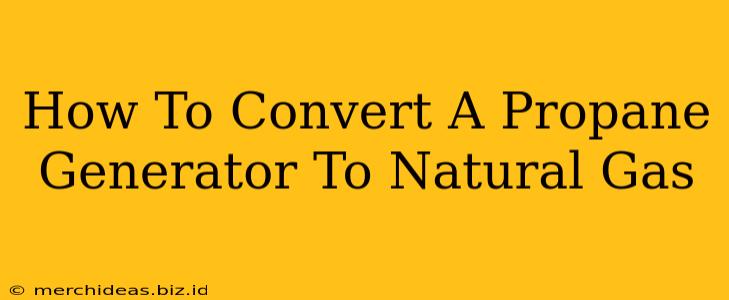Switching your propane generator to natural gas can offer significant cost savings and environmental benefits. Natural gas is often cheaper than propane, and burning it produces fewer greenhouse gas emissions. However, this conversion isn't a simple task and requires careful planning and execution. This comprehensive guide will walk you through the process, highlighting crucial safety precautions and necessary steps.
Understanding the Differences: Propane vs. Natural Gas
Before diving into the conversion process, it's vital to understand the key differences between propane and natural gas. These differences directly impact the conversion process:
- Pressure: Propane generators are designed for higher pressure than natural gas systems. Natural gas has a much lower pressure.
- BTU Content: Natural gas has a lower BTU (British Thermal Unit) content per cubic foot compared to propane. This means you'll need to adjust the generator's settings to compensate for the difference in fuel energy.
- Gas Composition: The chemical composition differs significantly. Propane is a single hydrocarbon, while natural gas is primarily methane with trace amounts of other gases.
Is Your Generator Convertible?
Not all propane generators are designed for conversion. Check your generator's owner's manual carefully. Look for specific information about natural gas conversion compatibility. Some generators explicitly state that conversion is possible, while others may warn against it. If your manual doesn't mention conversion, contact the manufacturer directly before proceeding. Attempting a conversion on an incompatible generator can lead to serious damage or even injury.
Necessary Tools and Materials
Converting your propane generator requires specific tools and materials. You'll likely need:
- Natural gas conversion kit: This kit will include the necessary regulators, fittings, and other components specific to your generator model. Always use a kit specifically designed for your generator.
- Wrench set: To securely tighten and loosen connections.
- Gas leak detector: This is crucial for safety. A leak detector will help you identify any gas leaks during and after the conversion.
- Pipe sealant: To ensure airtight connections and prevent gas leaks.
- Appropriate sized tubing: This will connect the natural gas line to your generator. The size will be specified in your conversion kit's instructions.
- Safety glasses and gloves: Protecting yourself from potential injury is paramount.
Step-by-Step Conversion Process
Disclaimer: This guide provides general information. Always consult your generator's owner's manual and the instructions included with your natural gas conversion kit. If you are not comfortable performing this task, hire a qualified technician.
- Safety First: Turn off the generator and disconnect it from the power source. Ensure the propane tank is completely empty and disconnected.
- Consult the Manual: Carefully review your generator's manual and the conversion kit's instructions.
- Prepare the Generator: Disconnect the existing propane regulator and lines. Clean all connection points thoroughly.
- Install the Conversion Kit: Install the natural gas regulator and any necessary fittings according to the kit's instructions. Pay close attention to the orientation of the components.
- Connect the Gas Line: Connect the new natural gas line to your generator and ensure all connections are secure and sealed properly with pipe sealant.
- Leak Test: Use the gas leak detector to thoroughly check all connections for leaks. Never attempt to start the generator without verifying the absence of leaks.
- Adjust Settings (If Necessary): Your generator may require adjustments to its carburetor or other settings to compensate for the different BTU content of natural gas. Refer to your manual for specific instructions.
- Start the Generator: Once you've completed all steps and confirmed no leaks exist, start your generator and monitor its operation for any unusual sounds or behavior.
Post-Conversion Maintenance
Regular maintenance is essential after converting your propane generator to natural gas. This includes:
- Regular leak checks: Periodically check all gas connections for leaks.
- Filter changes: Change the air filter and any other filters as recommended in the owner's manual.
- Professional servicing: Schedule annual professional servicing to ensure your generator is operating efficiently and safely.
By following these steps and prioritizing safety, you can successfully convert your propane generator to natural gas. Remember, however, that this is a technical process, and if you're unsure about any aspect, it's best to seek professional assistance. Improper conversion can result in dangerous gas leaks, generator malfunction, and void your warranty.
